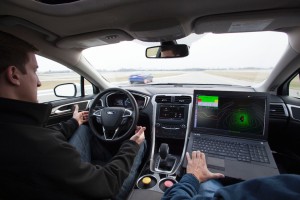
Ford announced its intention to fast-track its autonomous vehicle program in Silicon Valley, remaining competitive with other automakers.
Ford Motor Co. is joining the growing list of manufacturers planning to put an autonomous vehicle on the road.
The maker has announced it will put product development veteran Randy Visintainer in charge of its self-driving vehicle program. Elevating the profile of its autonomous vehicle program by moving the project from the research lab to its advanced engineering staff, which is in charge of making concept vehicles road worthy, means it’s on the fast track for production
The news follows last year’s announcement of a partnership between Ford and both the Massachusetts Institute of Technology and Stanford University aimed at solving some of the vexing technical challenges involved in autonomous driving.
During an event at Ford’s new Silicon Valley research center, company officials declined to lay out a target for putting autonomous vehicle technology into production. But they are clearly feeling pressure from competitors like Nissan, General Motors and Mercedes-Benz, never mind tech giant Google, considered one of the leaders in autonomous vehicle research.
“During the next five years, we will move to migrate driver-assist technologies across our product lineup to help make our roads safer and continue to increase automated driving capability,” said Raj Nair, Ford group vice president, Global Product Development. “At the same time, we are working to make sure those features and the whole way you shop for, buy and own a Ford vehicle provides an outstanding customer experience.”
Autonomous driving has been rapidly moving from the realm of science fiction to reality. Google has already clocked tens of thousands of miles testing self-driving prototypes – though it has experienced a few bumps along the way.
(Google reveals details of autonomous vehicle crashes – but blames the other drivers. Click Here for details.)
The Silicon Valley firm has begun rolling out a fleet of self-driving prototypes that will go into use around its headquarters. Google says it wants to find a partner to put its technology into production, rather than getting into the car business on its own.
Nissan, meanwhile, has promised to put its first fully autonomous vehicle into production in 2020. Before then, however, it plans to roll out several semi-autonomous technologies. That’s the approach a number of other manufacturers plan to take. Mercedes-Benz will add the ability to drive down a limited-access highway hands-free when it launches the next-generation E-Class next year. Cadillac will offer a similar feature, dubbed SuperDrive, on the CT6 sedan in 2017.
For its part, Ford is expanding the use of technologies that will serve as the foundation of autonomous vehicles. It will, for one thing, add Pre-Collision Assist with Pedestrian Technology to a U.S. vehicle next year. It is currently offered in Europe on the midsize Mondeo. This continues Ford’s plan to roll out the feature on most Ford products globally by 2019.
(Click Here to see how insurance companies are unlikely to be ready for autonomous vehicles.)
“Driver-assist features are part of the building blocks for increasingly capable semi-autonomous technology, as Ford enhances the sensors, algorithms and actuators in vehicles to create new fully automated driving technology,” the maker said in a statement outlining its plans for its Silicon Valley research center.
Ford F-150 has the most available driver-assist technology in the large light-duty pickup segment, while Edge and Explorer lead the midsize SUV segment, Fusion tops the midsize car segment and Taurus leads among large cars. Each vehicle has eight available driver-assist features, the independent analysis shows.
(For details about Tesla’s path to autonomous vehicles, Click Here.)
The Ford brand offers more nameplates in the United States with active park assist, rear cross-traffic alert, lane-departure warning with lane-keeping aid, and blind spot monitoring than any other mainstream manufacturer, according to SBD research.
Joseph Szczesny contributed to this report.

AVs are another means to sell EVs and thus pay lower fines for not meeting the 54.5 mpg CAFE requirement that Obama and the EPA decreed.
Ford is NO longer capable of engineering cars and will soon only import cars. This autonomous car crap is just another reason to not invest in vehicle engineering.